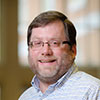This article is more than 5 years old.
Since Chris and Derrik have already written their accounts of the 2014 NASIG Conference, I figure I better get on the ball. This was an unusual conference experience for me. As Vice President of NASIG, I was very involved with the planning of this conference, as well as having to do a lot of organizational business. That organizational business included planning for next year’s conference, which will not only have a special celebration for our 30th anniversary, but will also have NASIG’s first ever joint programming with another organization, the Society for Scholarly Publishing. With all the meeting and talking I had to do, I’ll confess that I didn’t attend as many conference sessions as I normally do, but those I did attend were very interesting.
Chris and Derrik have given nice descriptions of the three vision sessions, which were all quite good. I think the most interesting break-out session I attended was “Acquisitions and Management of Digital Collections at the Library of Congress,” given by Ted Westervelt from LC. I’ve known Ted for years, but didn’t know how truly impressive and cool his job is. He manages the eDeposit program at LC, which acquires e-resources for the Library of Congress’s permanent collection. The Copyright Deposit section at LC is charged with preserving material for the life of the Republic, which is quite a long-term commitment. Since 2009, the Copyright Deposit section has required publishers to present two copies of every source deposited, but an exception was made for electronic material. The exemption was eventually dropped and now electronic journals and electronic books have to be given to LC for the Copyright Deposit program. In addition to deposited material, the eDeposit section acquires material through purchase and gifts. They currently have 116 million unique files in inventory with 2.74 petabytes of content. They are also providing web archiving for 8.6 billion files. The digital material acquired includes historical newspapers, web sites, reference works, e-serials, e-books, GIS data, and more than 60 other flows. The section’s operating philosophy is that preservation=access, or, as Ted said, you can’t serve what isn’t preserved. To that end, LC has developed a set of format specifications for electronic materials to be preserved through the eDeposit program (LC has not officially released these specifications yet, but Ted gave us a sneak peak). LC uses a wide range of digital tools to store and manage their digital content. He said that the repository is being built in stages, and that it is important to think of repositories as a suite of tools and services. That is, a repository isn’t a single thing where you stick e-resources and then they’re preserved forever, a repository is a process that relies on a number of tools. Ted also emphasized that you need to think of the entire lifecycle of a resources in a repository, which I think is very important. He pointed out that LC has a system in place for taking in materials, but that they need to scale it. They need to develop more digital collection breadth and depth. LC is currently demanding 230 e-serials via eDeposit, but they will quadruple the number in the next few months. They need more capacity, both for storage and for processing of materials, and they need more standard and automated workflows. They also need to develop their collection development, preservation, metadata and access policies. Even though that work still needs to be done, I find the scale and ambition of this project to be truly amazing and I look forward to hearing more about this work in the future (I’ll certainly be grilling Ted about his work when I see him again).
I also attended an interesting session by Rachel Erb of Colorado State University, who talked about how her library’s Technical Services department used NASIG’s recently published list of Core Competencies for Electronic Resources Librarians as a guide for reorganizing their department. Essentially they found that they had too few people working on electronic resources and that there were needed skills that the department was lacking. Using the Core Competencies as a guide, they were able to justify changing job descriptions (a hard task at their school) and to craft a justification for a new position to bring in the skills they needed. And I saw Richard Wallis from OCLC discuss linked data. The main thrust of his presentation was that libraries need to expose their data to the wider world, which is where linked data comes in. He used the pithy phrase, people want “things not strings.” That is they don’t just want entries, they want entities, entire data sets about a topic.
In addition to the sessions, I did a lot of great networking, and had good conversations about developments in the world of cataloging, serials management, and the future of NASIG. Speaking of the future of NASIG, we’ve got some exciting projects in the works that I can’t quite talk about yet, but I’ll share when I can. Oh, and at this conference I was inaugurated as president of NASIG, and I confirmed the fact that, despite my tendency to be a chatterbox in private conversation, I am the world’s worst public speaker. Ah well, they didn’t elect me to give speeches.

2 Comments on ‘Steve at NASIG 2014’
We are so proud of you, Steve. Being President of NASIG is a huge honor!!
Wow on the scope of the LC charge. I had to look up what a Petabyte was. Thanks for that overwhelming report on the LC and congratulations on your presidency!